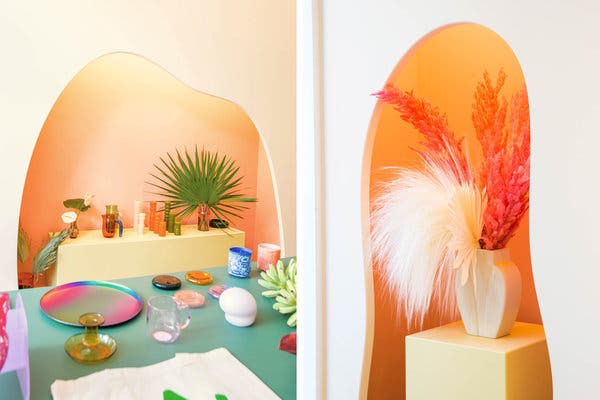Welcome back to the T List, a newsletter from the editors of T Magazine. Each week, we’re sharing things we’re eating, wearing, listening to or coveting now. We hope you’ll join us for the ride. (Sign up here, if you haven’t already, and you can reach us at tlist@nytimes.com.)
Visit This

By Julia Bainbridge
Before Elizabeth Jaime and her partner, Chaz Capobianco, opened the almost psychedelically colorful flower pop-up shop Calma in Miami’s Design District several weeks ago, the city had two choices when it came to floral arrangements, says Jaime: “uptight, traditional roses in a plain vase” or “rustic California wedding.” A prop stylist and former senior photo editor for Bon Appétit, Jaime immediately saw the need for something fresher when she moved back to Florida in December 2018, after nine years in New York. She favors medleys of tropical, traditional and playful flora, mixing anthuriums, for example, with tulips and pastel spray-painted monstera and livistona leaves. The resulting arrangements are somehow both statuesque and delicate. At Calma, shoppers can purchase premade bouquets or pick and choose from the stem bar in the back of the space, which Capobianco designed and built by hand, and also browse a selection of items for the kitchen and home, including Hay vases, Areaware planters and Beau Rush ceramics. The pop-up will be open through the end of March, “but if it’s successful, I’ll consider staying open longer,” Jaime says. If the enthusiastic shoppers who’ve visited so far are anything to go by, Calma is here to stay. calma-miami.com.
Try This
By Caitie Kelly
After one too many holiday parties, my under-eye region isn’t looking its best — lack of sleep and plenty of mulled wine will do that to you. Luckily, there’s a slew of new cooling, depuffing products that can help keep bags at bay. The Platinum Stem Cell Eye Mask from the London-based facialist Sarah Chapman is an innovative hydrogel mask that covers not only the under-eye area but also the skin above and below the brow bone, treating it with a hyaluronic acid and peptide-rich formula to deeply hydrate and brighten dark circles. La Prairie’s Skin Caviar Eye Lift, made with protein-rich caviar extract, also addresses the entire area, lifting and tightening the lids while diminishing bags. If that’s too pricey, Yes to Cucumbers’ Depuffing Under Eye Mask is a bargain at only $13, and includes caffeine and cucumber extract (ingredients meant to soothe and constrict skin), while Peach & Lily’s Cold Brew Eye Recovery Stick contains a light iridescence for an illuminating effect that helps hide dark circles — plus, the stick formula is perfect for midday touch-ups. Store any of these products in the refrigerator for an especially soothing effect.
See This
By Kurt Soller
The artist Tim Greathouse died of an AIDS-related illness at 48 in 1998. Now, two decades later, he’s the focus of an overdue exhibition — including high-contrast black-and-white portraits and ominous text-driven works on paper — at Daniel Cooney’s Chelsea gallery. Cooney is a keen curator of underappreciated artists from the ’80s-era East Village, where, in 1984, Greathouse opened Oggi Domani, then the neighborhood’s only photography gallery. Greathouse’s own shots speak to that scene’s intimacy and its deep reserves of creativity, much of which was lost to the disease; portraits of the artists David Wojnarowicz and Peter Hujar, in whose darkroom Greathouse learned to print, are stark reminders of this. I’m also drawn to the intimate images of Sur Rodney (Sur), the still-living artist who’s an archivist for Greathouse and others. “The story of the East Village and AIDS is still being told,” Cooney said to me. “Tim is one of those people who’s been overlooked.” Viewing his haunting work, I felt hopeful for the next rediscovery. “Tim Greathouse” is on view from Jan. 9 to Feb. 29, 2020, 508-526 West 26th Street, #9C, New York, danielcooneyfineart.com.
Buy This
By Sophie Bew
With a new decade comes the promise of a better self, and mine would be vastly improved by getting a better night’s rest. There’s little on my resolution list that doesn’t in some way relate to slumber: prepping for it, doing it, rousing from it. Enter Tekla, a Copenhagen-based homewares brand. Founded in 2017 by Charlie Hedin — who formerly worked in global communications for the Swedish fashion brand Acne Studios — Tekla’s spartan aesthetic borrows from Hedin’s love of minimalist architecture (last year he collaborated with the famed British architect John Pawson on two collections of exquisite mohair-blend blankets), and is borne out in its range of cotton percale sheets and plush, post-sauna-worthy towels. But it’s the brand’s robes that are the stuff of my dreams: Made from organic, chemical-free Oeko-Tex cotton and cut into boxy, hooded silhouettes, they come striped — in either purple and brown, dark and light blues or a ’70s wallpaper-esque blend of cream, brown and cornflower blue — and in solid hues, like lavender or ash gray. Any one would be a cozy addition to my (hopefully) improved sleep routine. $146, teklafabrics.com.
Wear This
By Alex Tudela
Whenever I’m in need of style inspiration, I find myself pulling up images of Prada’s early aughts men’s wear collections — their sporty minimalism, restrained tailoring and boyish quirk usually breaks my rut. As of today, those looks could find their way into my closet: To celebrate the launch of its new men’s category, which will go live later this month, the German luxury e-commerce site Mytheresa has partnered with Prada on a 42-piece range reminiscent of the fashion house’s spring 2000 men’s collection. The offering includes windbreaker jackets and vests, jogging pants in various colors, bucket hats and even a nylon jumpsuit. But the garments that most embody the Y2K spirit are perhaps the pink dégradé nylon anoraks and trousers that zip off into shorts. From about $430, mytheresa.com.
From T’s Instagram




